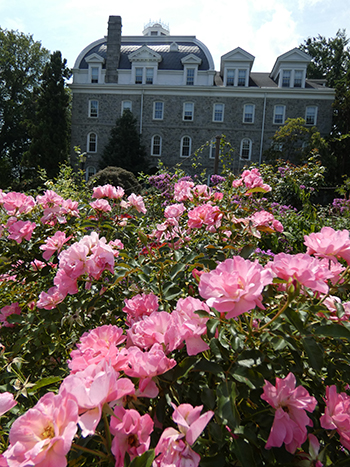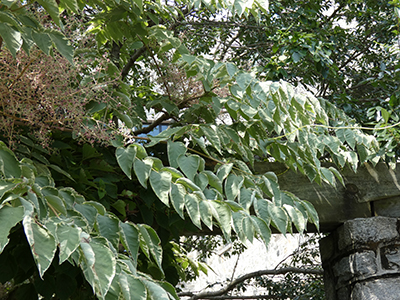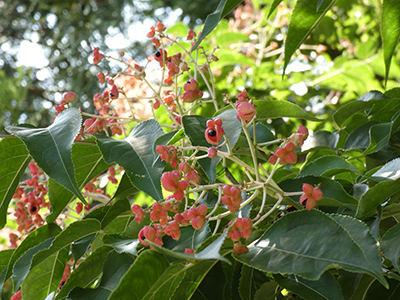
Plants of the Week: August 26
Guest Author: Rosemary Grogan, 2019 summer intern

Rosa ‘KORfeining’ (MaxiVitaⓇ Rose)
Rosa ‘KORfeining’ is a perennial shrub that has orange pink blooms during the spring, summer, and occasionally early fall. ‘KORfeining’ can reach up to 60 to 70 cm and spread from 40 to 50 centimeters wide. This floribunda has medium blooms that are semi-double flowered and non fragrant. Floribundas have been around since the early 1900’s and their name suggests their habit. The shrub has abundant flowers and there are usually multiple blooms per stem. Find these roses blooming in the Dean Bond Rose Garden. Photo credit: R. Grogan

Aralia elata ‘Aureovariegata’
Aralia elata (angelica tree) is a small, deciduous tree native to China, Japan, Korea and eastern Russia. In the wild, Aralia elata can grow to a height of 20 to 40 feet tall, while in domestic gardens, the plant is usually seen as a shrub that reaches from 12 to 18 feet high.
The plant has thorny bark, topped with an umbrella of jagged-edged leaves. In August, small white flowers bloom in large panicals near the ends of branches. Clusters of black drupes follow the flowers, which ripen from late summer to early fall. The cultivar ‘Aureovariegata’ is known for its yellow-edged leaflets. Find this unique tree near Kohlberg Hall, bordering the Isabelle Cosby Courtyard. Photo credit: R. Grogan

Euscaphis japonica
Euscaphis japonica is native to valleys, open forests, and thickets in China, Japan and Korea. J.C. Raulston found this tree on the Korean Peninsula while on a U.S. National Arboretum collection expedition in 1985. Raulston brought seeds back to the U.S. to the North Carolina State Arboretum
The name Euscaphis is derived from the Greek words eu meaning good and scaphis meaning a vessel after the shape of the tree’s seed pods. Around this time, the heart-shaped seed pods can be seen, reaching full ripeness from September to October. When at peak ripeness, the bright red pods will split open to reveal small black seeds. You can find this tree adjacent to Beardsley and Trotter Halls. . Photo credit: R. Grogan





Cindy Mehallow
Posted at 09:18h, 29 AugustUnless I am mistaken, aralia elata is widely recognized as a non-native invasive plant and should not be planted in U.S. gardens. For example, refer to the US Dept. of Agriculture website. https://invasive-species.extension.org/2019/07/aralia-elata-japanese-angelica-tree/ I’m very surprised and disappointed that the Scott Arboretum would advocate planting this species.
Mary Tipping
Posted at 10:27h, 29 AugustWe appreciate your concern about Aralia elata. Plant “invasiveness” tends to be a regional issue since plants that possess invasive tendencies in one region may not behave in the same manner in another. Our Aralia elata ‘Aureovariegata’ specimen produces very few seedlings and does not exhibit aggressive or invasive tendencies. Conversely, many of our native species such as Cercis canadensis, Acer saccharum, and Fraxinus americana self-sow readily, yet we do not consider them thugs. Periodic monitoring and a bit of hand-weeding helps us to keep their populations in-check.
Rosemary Grogan
Posted at 11:57h, 29 AugustDear Ms. Mehallow,
Thank you for you comment. Yes, indeed, Aralia elata is nonnative and can be invasive in wild conditions. The particular cultivar, ‘Aureovariegata,’ was planted in 2000 at the Scott Arboretum. The tree was planted in a controlled arboretum environment, so I understand your concern for at home gardeners.
Thank you very much for your research and interest in this blog post.
Rosemary Grogan
This is where to find the tree at the arboretum – http://arbnav.scottarboretum.org/weboi/oecgi2.exe/INET_ECM_DisplayPlant?ACCNUM=2000-054*A